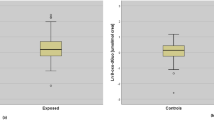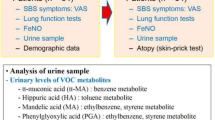Abstract
Indoor VOC and aldehydes may increase oxidative stress for home dwellers. Our study aim was to determine the correlations between oxidative stress markers in subjects and exposure to VOC and aldehydes in homes. Among ninety five control subjects in Ansan and Incheon (South Korea), blood samples were collected for evaluation of total antioxidant capacity, malondialdehyde (MDA) in plasma, protein carbonyl, and DNA damage of lymphocytes. Indoor VOC and aldehydes were measured in the homes of the subjects. A partial correlation analysis was performed to assess the association between oxidative stress markers and VOC/aldehydes with adjustment for formaldehyde levels. There were significant correlations between the total antioxidant capacity and some chemicals, including heptanes, α-pinene, β-pinene, and decanal in the young age (10–19 years) group. The many correlations between VOC/aldehydes and DNA damage expressed as the Olive tail moment showed statistically significant in the middle (20–39 years) and older age (40–59 years) groups, but not in the young age group. These correlation could not account for the exposure to specific chemicals being related to an increase in DNA damage because most VOC/aldehydes were highly correlate exac other except some chemicals. In conclusion, we found that DNA damage of T- and B-lymphocytes evaluated by the Comet assay could be sensitive oxidative stress markers to evaluate the human response to VOC/ aldehydes exposure in middle and older age groups. Our study also showed that age affected the association between VOC/aldehydes exposure and oxidative stress markers including DNA damage and antioxidants. However, further studies are needed to confirm these correlations in a larger number of subjects because of limitations of this study, including a lack of personal exposure.
Similar content being viewed by others
References
Suh, H. E., Bahadori, T., Vallarino, J. & Spengler, J. D. Criteria air pollutants and toxic air pollutants.Environ Health Perspect 108, 625–633 (2000).
Sexton, K.et al. Comparison of personal, indoor, and outdoor exposures to hazardous air pollutants in three urban communities.Environ Sci Technol 38, 423–430 (2004).
Wallace, L., Nelson, W. & Ziegenfus, R. The Los Angels TEAM study: Personal exposures, indoor-outdoor air concentrations, and breath concentrations of 25 volatile organic compounds.J Expo Anal Environ Epidemiol 1, 157–192 (1991).
Ayoko, G. A. inThe Handbook of Environmental Chemistry Vol. 4 (Springer-Verlag Berlin Heidelberg, New York, 2004).
Wolkoff, P., Wilkins, C. K., Clausen, P. A. & Nielsen, G. D. Organic compounds in office environmentssensory irritation, odor, measurements and the role of reactive chemistry.Indoor Air 16, 7–19 (2006).
Sunesson, A. L., Rosen, I., Stenberg, B. & Sjostrom, M. Multivariate evaluation of VOC in buildings where people with non-specific building-related symptoms perceive health problems and in buildings where they do not.Indoor Air 16, 383–391 (2006).
Saijo, Y.et al. Symptoms of sick house syndrome and contributory factors: Study of general dwellings in Hokkaido.Nippon Koshu Eisei Zasshi 49, 1169–1183 (2002).
Ando, M. Indoor air and human health-sick house syndrome and multiple chemical sensitivity.Kokuritsu Iyakuhin Shokuhin Eisei Kenkyusho Hokoku 120, 6–38 (2002).
Koyasu, Y.et al. Epidemiologic study on the prevalence of the sick house syndrome in Japan.Arerugi 53, 484–493 (2004).
Seki, A.et al. Review of sick house syndrome.Nippon Eiseigaku Zasshi 62, 939–948 (2007).
Kwon, K. D., Jo, W. K., Lim, H. J. & Jeong, W. S. Characterization of emissions composition for selected household products available in Korea.J Hazard Mater 148, 192–198 (2007).
Park, S., Kim, H., Sim, S. H., Lee, S. H. & Koo, J. W. Concentrations of VOC and formaldelhyde in newly constructed apartment buildings before and after residence.Kor J Env Hlth 33, 98–103 (2007).
Brauer, C., Kolstad, H., Orbaek, P. & Mikkelsen, S. No consistent risk factor pattern for symptoms related to the sick building syndrome: A prospective population based study.Int Arch Occup Environ Health 79, 453–464 (2006).
Park, J. S. & Ikeda, K. Exposure to the mixtures of organic compounds in homes in Japan.Indoor Air 14, 413–420 (2004).
Rumchev, K., Spickett, J., Bulsara, M., Phillips, M. & Stick, S. Association of domestic exposure to volatile organic compounds with asthma in young children.Thorax 59, 746–751 (2004).
Mendell, M. J. Indoor residential chemical emissions as risk factors for respiratory and allergic effects in children: A review.Indoor Air 17, 259–277 (2007).
Garrett, M. H., Hooper, M. A., Hooper, B. M., Rayment, P. R. & Abramson, M. J. Increased risk of allergy in children due to formaldehyde exposure in homes.Allergy 54, 330–337 (1999).
Arif, A. A. & Shah, S. M. Association between personal exposure to volatile organic compounds and asthma among US adult population.Int Arch Occup Environ Health 80, 711–719 (2007).
Wieslander, G., Norbäck, D., Björnsson, E., Janson, C. & Boman, G. Asthma and the indoor environment: the significance of emission of formaldehyde and volatile organic compounds from newly painted indoor surfaces.Int Arch Occup Environ Health 69, 115–124 (1997).
Kelly, F. J. Oxidant stress; Its role in air pollution and adverse health effects.Occup Environ Med 60, 612–616 (2003).
Lu, C. Y., Ma, Y. C., Lin, J. M., Chuang, C. Y. & Sung, F. C. Oxidative DNA damage estimated by urinary 8-hydroxydeoxyguanosine and indoor air pollution among non-smoking office employees.Environ Res 103, 331–337 (2007).
Gulec, M.et al. Antioxidant enzyme activities and lipid peroxidation products in heart tissue of subacute and subchronic formaldehyde-exposed rats: A preliminary study.Toxicol Ind Health 22, 117–124 (2006).
Mayne, S. T. Antioxidant nutrients and chronic disease: Use of biomarkers of exposure and oxidative stress status in epidemiologic research.J Nutr 133, 933S-940S (2003).
Ghiselli, A., Serafini, M., Natella, F. & Scaccini, C. Total antioxidant capacity as a tool to assess redox status: critical view and experimental data.Free Radic Biol Med 29, 1106–1114 (2000).
Briggs, D. Environmental pollution and the global burden of disease.Br Med Bull 68, 1–24 (2003).
Georghiou, P. E., Snow, D. & Williams, D. T. Formaldehyde monitoring in urea-formaldehyde foam-insulated houses in St. John’s, Newfoundland, Canada; Correlative field evaluation of a real-time infrared spectrophotometric method.Environ Int 9, 279–287 (1983).
Clarisse, B.et al. Indoor aldehydes: Measurement of contamination levels and identification of their determinants in Paris dwellings.Environ Res 92, 245–253 (2003).
Habif, S.et al. Age and gender dependent alterations in the activities of glutathione related enzymes in healthy subjects.Clinical Biochemistry 34, 667–671 (2001).
Ashok, B. T. & Ali, R. The aging paradox: Free radical theory of aging.Exp Gerontol 34, 293–303 (1994).
Yeh, C. C.et al. No effect of cigarette smoding dose on oxidized plasma proteins.Environ Res 106, 219–225 (2008).
Mariani, E.et al. Antioxidant enzyme activities in healthy old subjects; Influence of age, gender and zinc status.Biogerontology 7, 391–398 (2006).
Barja, G. Rate of generation of oxidative stress-related damage and animal longevity.Free Radic Biol Med 33, 1167–1172 (2002).
Ichiba, M.et al., Significance of urinary excretion of 8-hydroxy-2’-deoxyguanosine in healthy subjects and liver disease patients.Hepato-Gastroenterology 54, 1736–1740 (2007).
Mentese, S. & Güllü, G. Variations and sources of formaldehyde levels in residential indoor air in ankara, Turkey.Indoor Built Environment 15, 273–281 (2006).
Moon, K. W.et al. Risk assessment of aldehydes in some residential indoor air included atopy patient’s homes.Kor J Env Hlth 32, 19–26 (2006).
Sul, D.et al. Single strand DNA breaks in T- and Blymphocytes and granulocytes in workers exposed to benzene.Toxicology Letters 134, 87–95 (2002).
Sul, D.et al. DNA damage in T- and B-lymphocytes and granulocytes in emission inspection and incineration workers exposed to polycyclic aromatic hydrocarbons.Mutat Res-Gen Tox En 538, 109–119 (2003).
Habdous, M.et al. Serum total antioxidant status, erythrocyte superoxide dismutase and whole-blood glutathione peroxidase activities in the Stanislas cohort: Influencing factors and reference intervals.Clin Chem Lab Med 41, 209–215 (2003).
Bolzan, A. D., Bianchi, M. S. & Bianchi, N. O. Superoxide dismutase, catalase and glutathione peroxidase activities in human blood: Influence of sex, age and cigarette smoking.Clin Biochem 30, 449–454 (1997).
Ho, S. P., Chan-Yeung, M., Chow, K. K., Ip, M. S. & Mak, J. C. Antioxidant enzyme activities in healthy Chinese adults: Influence of age, gender and smoking.Respirology 10, 305–309 (2005).
Rush, J. W. & Sandiford, S. D. Plasma glutathione peroxidase in healthy young adults: Influence of gender and physical activity.Clin Biochem 36, 345–351 (2003).
Bates, C. J., Prentice, A. & Finch, S. Gender differences in food and nutrient intakes and status indices from the National Diet and Nutrition Survey of people aged 65 years and over.Eur J Clin Nutr 53, 694–699 (1999).
Picot, I. C., Trivier, J. M., Nicole, A., Sinet, P. M. & Thevenib, M. Age correlated modifications of copperzinc superoxide dismutade and glutathione related enzyme activities in human erythrocytes.Clin Chem 38, 1–66 (1992).
Mendoza-Nunez, V. M., Ruiz-Ramos, M., Sanchez-Rodriguez, M. A., Retana-Ugalde, R. & Munoz-Sanchez, J. L. Aging-related oxidative stress in healthy humans.Tohoku J Exp Med 213, 261–268 (2007)
Jones, D. P., Mody, V. C., Carlson, J. L., Lynn, M. J. & Sternberg, P. Redox analysis of human plasma allows separation of pro-oxidant events of aging grom decline in antioxidant defenses.Free radic Biol Med 33, 1290–1300 (2002).
U.S. Environmental Protection Agency, 1999b, Determination of Volatile Organic Compounds (VOC) in Air Collected in specially-prepared canisters and analyzed by Gas Chromatography/Mass spectrometry (GC /MS): Method TO-14: EPA-625/R-96-010b, Washington, DC.
U.S. Environmental Protection Agency, 1999a, Determination of Formaldehyde in Ambient Air Using Absorbent Cartridge Followed by High Performance Liquid Chromatography (HPLC) (active sampling method): Method TO-11: EPA-625/R-96-010b, Washington, DC.
Singh, N. P., McCoy, M. T., Tice, R. R. & Scnider, E. L. A simple technique for quantification follow levels of DNA damage in individual cells.Exp Cell Res 175, 184–191 (1988).
Seljeskog, E., Hervig, T. & Mansoor, M. A. A novel HPLC method for the measurement of thiobabituric acid reactive substances (TBARS). A comparison with a commercially available kit.Clin Biochem 39, 947–954 (2006).
Fagan, J. M., Sleczka, B. Z. & Istvan, S. Quantitation of oxidative damage to tissue proteins.Int J Biochem Cell Biol 31, 751–757 (1999).
Author information
Authors and Affiliations
Rights and permissions
About this article
Cite this article
Hong, E., Lee, E., Kim, Y. et al. The correlations between oxidative stress markers and indoor volatile organic compounds among the general population in Ansan and Incheon cities, Korea. Toxicol. Environ. Health. Sci. 1, 37–48 (2009). https://doi.org/10.1007/BF03216462
Issue Date:
DOI: https://doi.org/10.1007/BF03216462




